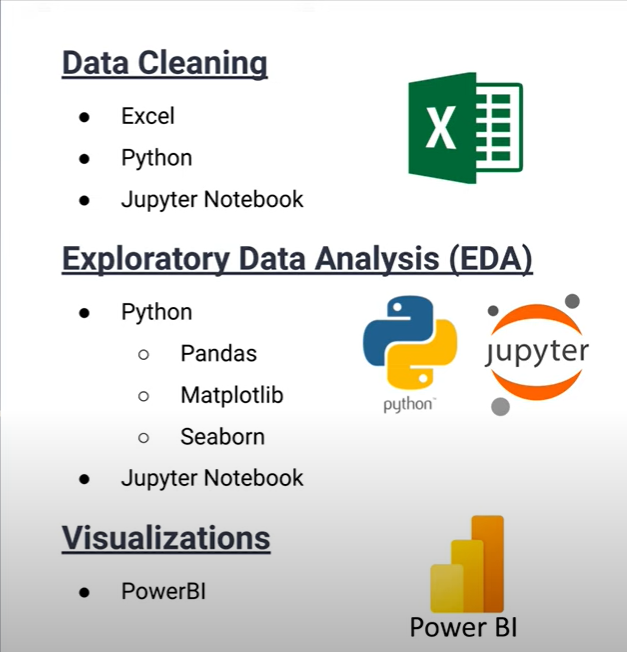What is the problem?
In today's rapidly evolving economic landscape, families are increasingly finding themselves in a precarious position as the costs of essential goods such as housing and groceries continue to soar. With rising prices putting immense pressure on household budgets, many families are compelled to adopt dual-income models to stay afloat. However, this shift presents its own set of challenges. Balancing the demands of career and parenthood, managing childcare costs, and maintaining a work-life equilibrium can be incredibly taxing.
This analysis aims to shed light on the pressing need for employers to create family-friendly work environments that support working parents. By examining the current financial strains and their impact on families, this presentation seeks to underscore the importance of workplace policies that accommodate the realities of modern parenting and help alleviate the burden on dual-income households.
Data Collection and Analysis
For this project, I couldn't rely on a single data set to gather all the information necessary. Consequently, I had
to collect data from multiple sources, including the U.S. Department of Labor, U.S. Bureau of Labor Statistics, OECD
Labor Force Statistics, Census.gov, and others. The next step involved cleaning and merging the data, primarily
using Excel, followed by some Python cleaning work in a Jupyter notebook.
During my exploratory data analysis and preliminary visualizations, I utilized Python and libraries such as Pandas,
Matplotlib, and Seaborn within a Jupyter notebook. Final visualizations were developed with Microsoft Power BI.
Rising Consumer Prices
One of the most crucial indicators of our cost of living is the Consumer Price Index (CPI). The CPI reflects changes
in the purchasing power of the dollar over time. The CPI is based on a market “basket” of consumer goods and services,
comprising eight categories: food and beverages, housing, apparel, transportation, medical care, recreation, education
and communication, and miscellaneous. Housing carries the heaviest weight in the CPI, meaning that as housing costs rise,
so does the CPI. We'll explore this further in a moment.
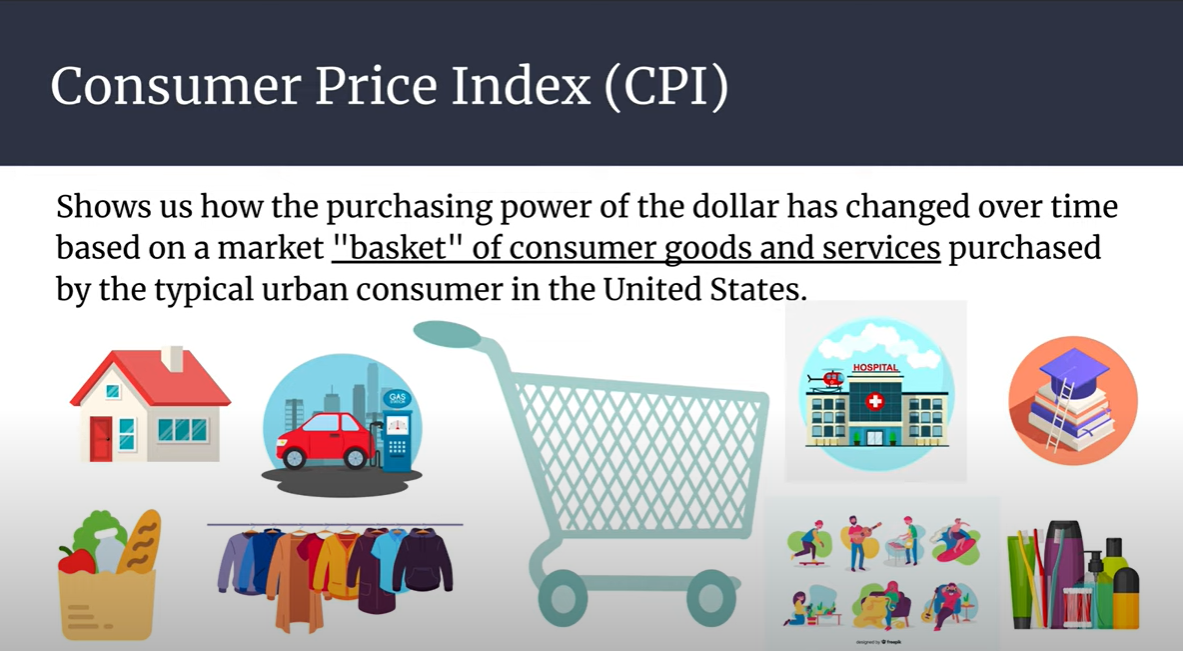
Examining the CPI over the last 60 years reveals a massive increase of 240 points. To put this into perspective,
$150 in 1960 would buy you the same amount of goods as nearly $1,400 in 2021. Similarly, $150 in 2000 would equate
to $236 in 2021. In short, prices are rising significantly.
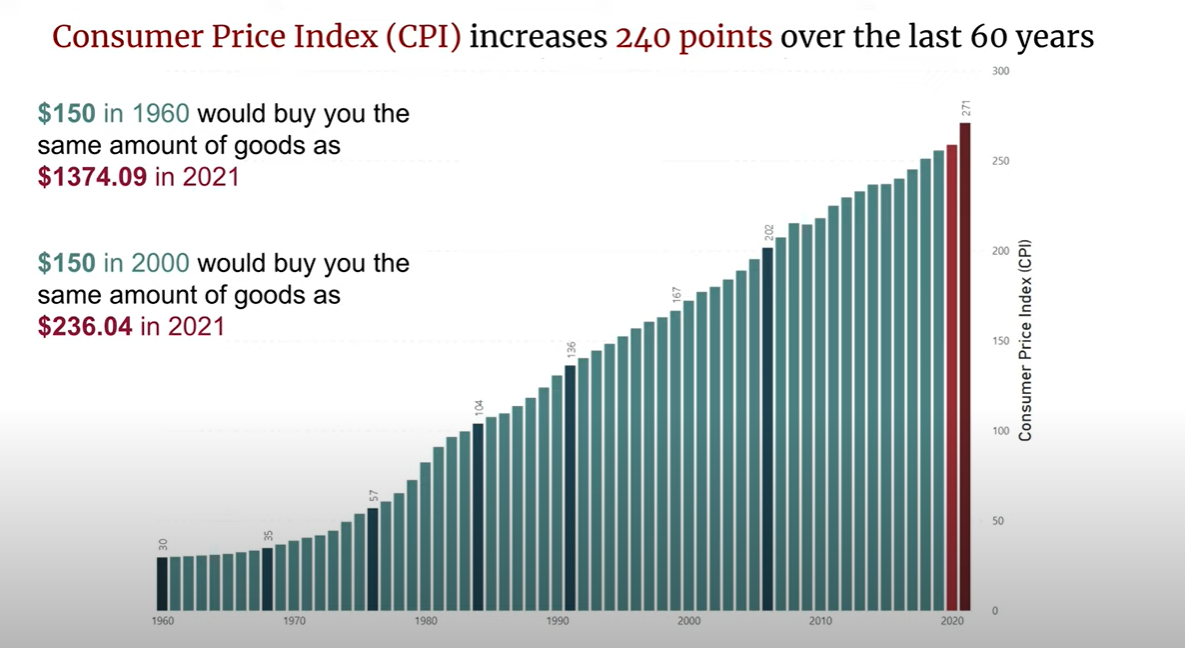
Housing Prices vs. Median Income
Housing is a major factor in the CPI. The median sales price of U.S. homes has seen a dramatic increase over the past
six decades. In 1960, the median sales price of homes was $18,000. By 2013, it had surged to over $250,000—a quarter
of a million dollars.
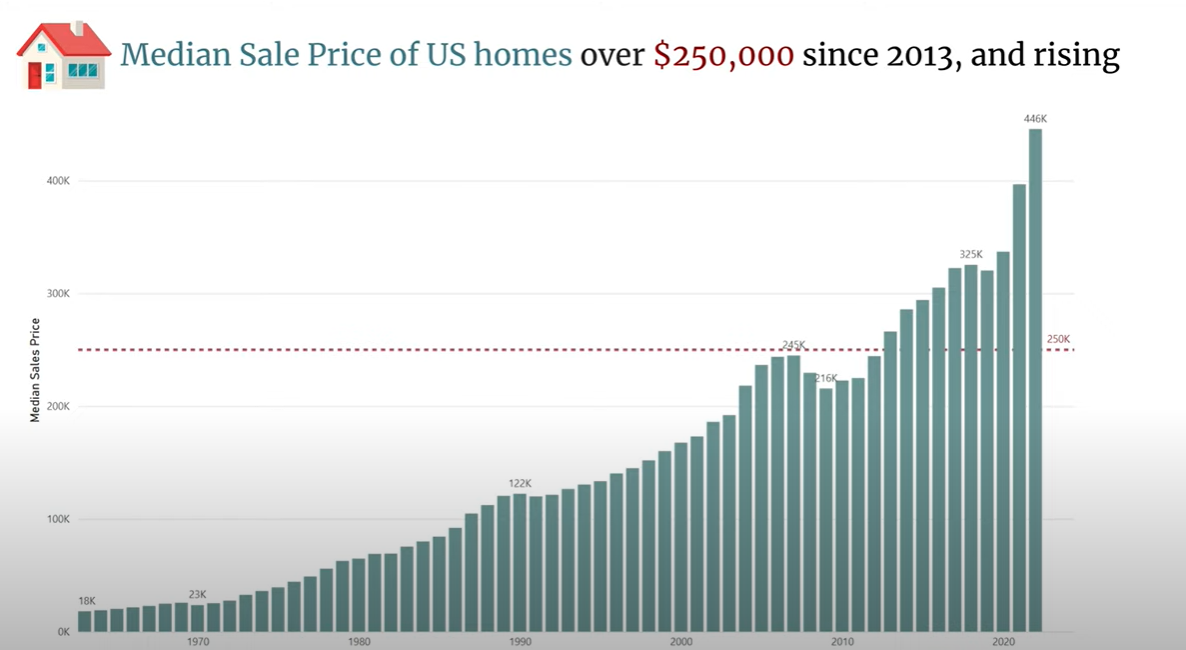
While rising prices in homes and other goods wouldn't be as concerning if incomes kept pace, the reality is starkly different.
Comparing the rise in home prices to median income reveals a significant disparity. In 1984, the median home price was four
times the median income. By 2021, it was 5.6 times the median income, and even higher in 2022.
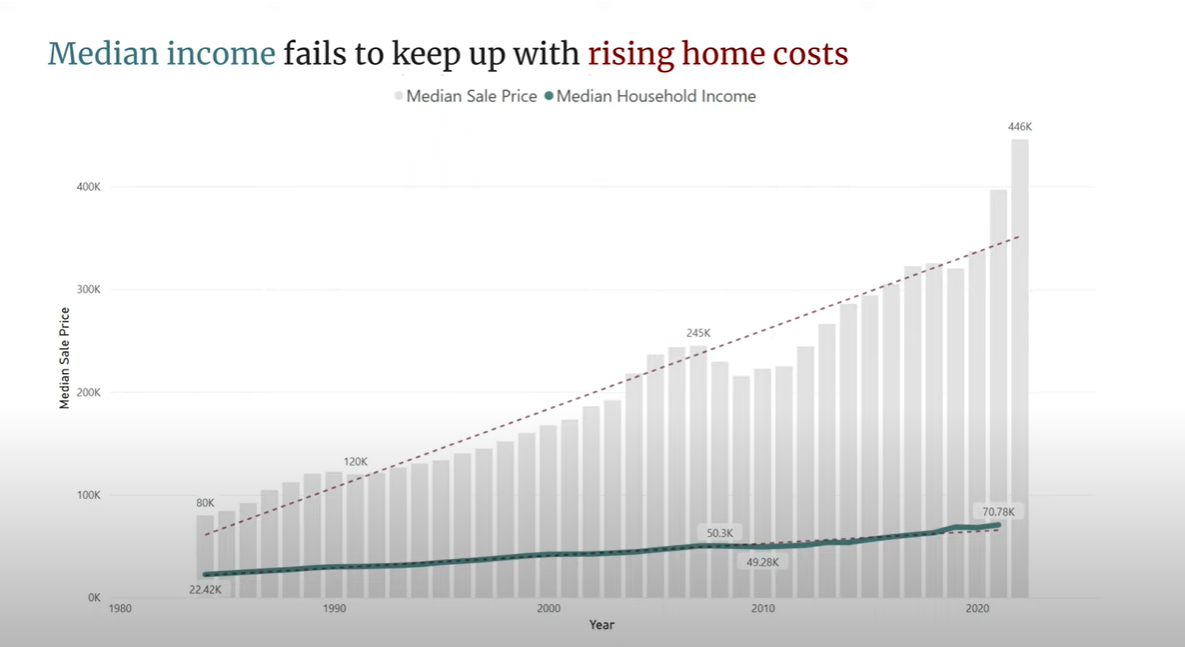
The Housing Market and Economic Events
To understand U.S. home prices further, we must consider historical events. In December 2007, the housing market crashed,
plunging the U.S. into a financial crisis. Generally, houses will either increase or maintain their value, but the 2008
Great Recession marked the first time in a century that housing prices fell. Then, in 2020, the COVID-19 pandemic led to
an unprecedented 39% increase in home prices within just three years.
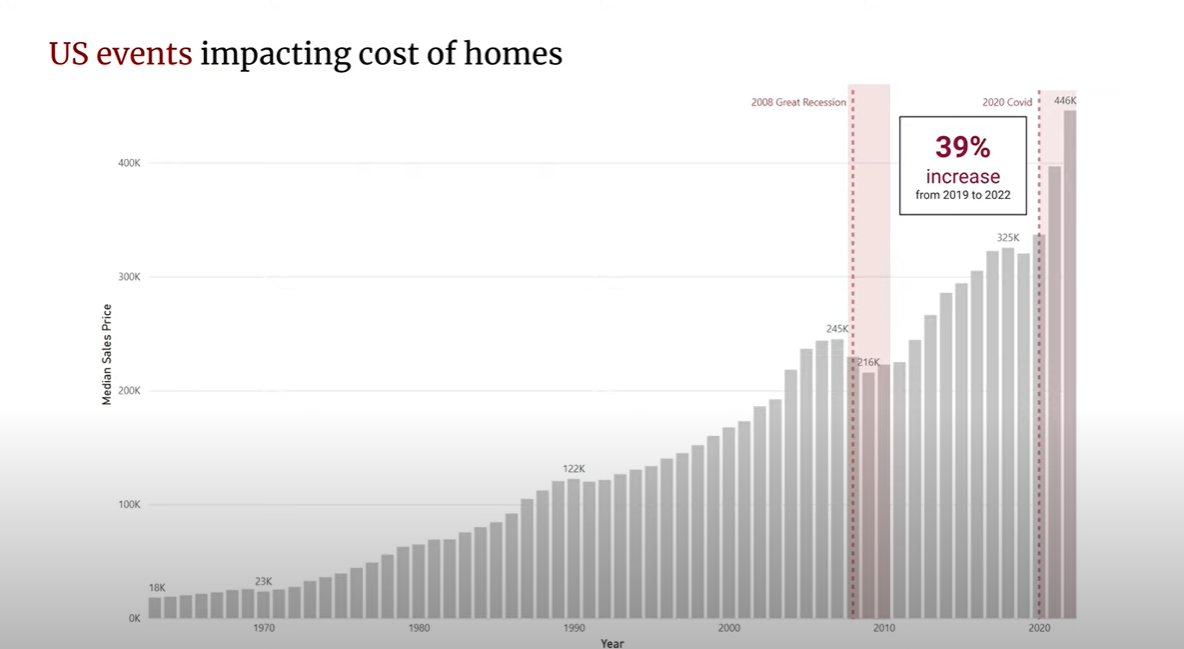
Given the skyrocketing prices, many, especially first-time homebuyers, are left wondering if there's an impending market crash.
However, comparing conditions from 2007 to those of 2022 explains why most experts predict otherwise. There were 116 million
households in 2007 and 128 million in 2022. New housing starts were 2.1 million in 2007, but only 1.4 million in 2022. In 2007,
there were 4 million houses in inventory ready to be sold, compared to just 860,000 in 2022. With 12 million more potential
buyers and significantly lower supply, demand far outweighs supply, indicating that high housing prices are likely here to stay.

The Necessity of Dual-Income Families
With the cost of living and housing only increasing, the question arises: How do we afford it? The answer lies in dual-income
families. Analyzing the number of employed women per capita, particularly those aged 25 to 34, shows the greatest increase in
employment since the 1960s. This age group, traditionally the demographic having children, is now significantly
represented in the workforce. This shift may indicate that staying home to maintain a household is no longer a viable option.
If women in their childbearing years choose to stay home, they face significant financial strain, making it necessary for many
to work just to keep up with the rising cost of living.
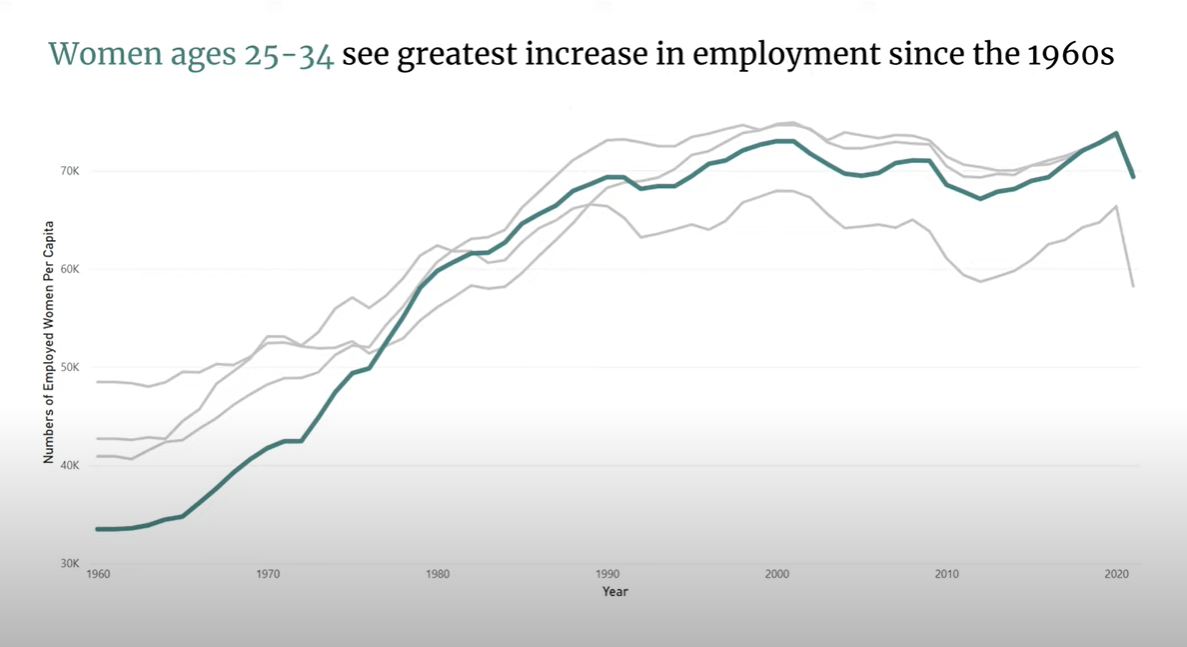
Comparing employment numbers reveals that most families already rely on combined incomes from both spouses. While there was a
slight dip in 2008, likely due to unemployment, the overall trend continues to rise. Mothers can no longer afford to stay at home
because their families depend on their income.
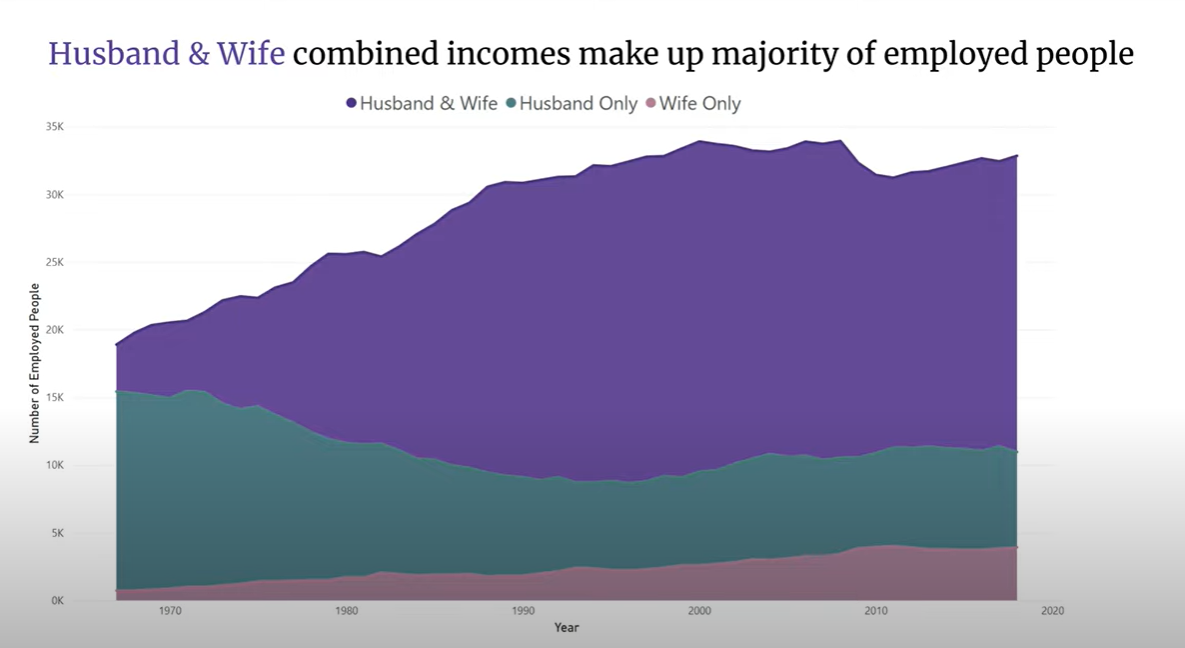
Proposed Solutions
So, what can we do about this? The reflex is often to focus on elaborate economic measures that require considerable resources and
more time than struggling families can afford to wait. Companies and employers can make a real difference today by adopting methods
that directly support families. So again the question, what can we do about this? My answer: normalize families in work environments.
They most assuredly are going to be there.
Here are my proposed action steps:
- Make Companies Family-Friendly
Encourage companies to be accepting of employees' families. Don't hide your family from your
employer. Where applicable, companies should allow employees to have their children in the background during Zoom meetings without
making it a big deal. Coworkers and managers alike can offer patience and grace when a parent needs to step away to take care
of family matters.
- Flexible Schedules
Offer flexible schedules. Top professionals increasingly gravitate toward companies that prioritize
flexibility, and by doing so, businesses can significantly expand their talent pool. Many mothers, myself included, are highly
productive during the early morning or late evening hours, often needing time in the afternoon for school drop-offs and pick-ups.
However, they are ready to resume work later in the day. Allowing working parents the flexibility to complete tasks from home or
join meetings virtually, when feasible, not only supports their ability to balance work and family but also enhances the company's
ability to attract and retain top-tier talent.
- Substantial Maternity and Paternity Leave
This should be standard practice. Supporting a mother during the early days with a
new baby is crucial, and a key aspect of this support is allowing her spouse or partner to be home as well. The early postpartum
period is critical for both physical recovery and bonding with the newborn. When a partner is given the opportunity to be present,
it not only eases the mother's burden but also helps ensure that she feels more supported and valued. This approach can make mothers
feel more confident about returning to work after their leave and more happy to do so, ultimately aiding in talent retention and
fostering a more committed and engaged workforce.
- Increase Part-Time Positions
Increase the availability of part-time positions. Many parents would love to contribute to their
family income on a part-time basis, especially when traditional 9-to-5 hours do not align with their household needs. Part-time roles
can facilitate the maintenance of licenses and skill sets. As circumstances change, children grow older, and parents' time constraints
decrease, these part-time employees can transition to full-time roles ultimately reducing onboarding time, accelerating time-to-value,
and saving the company money.
- Permanent Remote and Hybrid Positions
Make these options permanent. Employees should not live in fear of taking a position with
a concern that the remote or hybrid benefit will one-day be rescinded and workers forced back to the office. While we value the
camaraderie of in-person interactions, many employees would prefer to spend their breaks with their families. Furthermore, remote work
provides essential flexibility for parents, such as when a child becomes sick and cannot attend school or daycare. By offering permanent
remote and hybrid positions, companies support a better work-life balance, enhance employee satisfaction, and accommodate the diverse
needs of their workforce.
- In-House Daycares, Child Care Credits, and Stipends
Offering these as part of benefits packages can significantly decrease the
childcare cost burden on families. Many families find themselves opting for a single income because the net pay of the second-income
worker, after covering childcare expenses, amounts to zero. By supporting childcare needs, companies can, again, boost employee retention,
attract top talent, and demonstrate their recognition of the importance of family, reinforcing their commitment to a supportive and
inclusive workplace. Imagine nurses being able to check on their children at the hospital's employee daycare during breaks, making long
shifts more manageable.
- Normalize Career Breaks and Resume Gaps
They aren't a big deal, especially considering the numerous reasons someone might need a
break from work, such as caregiving, addressing personal physical or mental health, or pursuing further education. Many mothers take
career breaks (or as my friend calls it, a "Power Pause"), but this doesn't mean mothers aren't still developing valuable skills.
Managing a household, balancing a budget, coordinating evolving schedules, and handling daily crises under pressure enhances high-demand
soft skills such as problem-solving, time management, adaptability, negotiation, communication, organization, and leadership. These
experiences contribute to a person's growth and resilience making them emotionally present and prepared to add value to their
companies upon re-entering the workforce.
Conclusion
By implementing these actions, we can create a more supportive and equitable workplace for both mothers and fathers. Offering flexibility,
providing childcare support, and normalizing career breaks help working parents balance their professional and family responsibilities. In
our current economic environment, raising a family on a single income has become an increasingly rare luxury, making it essential for working
parents, particularly working mothers, to receive support from their employers. These changes not only enhance employee satisfaction and
retention but also strengthen our organizations by leveraging a diverse range of skills and experiences. Ultimately, by embracing these
strategies, we foster a work environment where all employees are empowered to thrive, contributing to their families and our collective
success.
Background Story: Why this topic interested me
My name is Kelsey Taylor, I am a wife and mother to two children and am currently employed as an Analytics Engineer.
I started my journey into a tech career out of desperate necessity to provide for my family, so the topic of mothers
in the workforce is of particular interest to me. When my husband got sick back in 2021, I was a stay-at-home mom
with no skillset or means to find work that could provide for my family. I found Tech-Mom’s and graduated Fall 2021,
and so began my journey to break into tech.
The skills Tech-Mom’s taught me, and the confidence they instilled, opened the door for a scholarship opportunity thereby allowing me to participate in
DevMountain’s Programming Bootcamp where I specialized in Data Analytics. Graduation from there was followed by an
Analytics Engineering internship, and eventual full-time employment as an Analytics Engineer, all while being a
full-time mother and caretaker to my 2-year-old and newborn baby.
